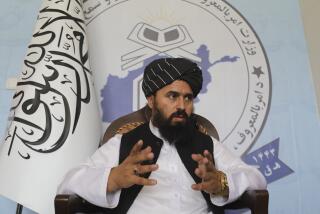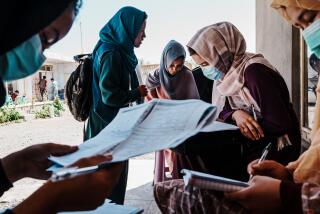Afghan Art, Artifacts Also Fall Victim
- Share via
KABUL, Afghanistan — Its present shattered, its future badly compromised, this nation on the hinge of Central and South Asia has been plundered of a goodly share of its past as well by the continuing civil war.
“We Afghan people are very proud of our history. But now we are cut off from it,” reflected Amir S. Hassanyar, chancellor of Kabul University, sadly mulling over the cultural cost of 17 years of fighting.
For not only has the ongoing Afghan conflict killed about 1 million people and devastated the lives and livelihoods of millions more--it has also ravaged the architectural and artistic heritage of a land that uniquely fused influences from East and West: Greek and Buddhist, Persian and Mongol, Islamic and Hindu.
“We used to come here for picnics,” Rafiullah, a 23-year-old Kabul resident now without a job, said as he gazed at the near-desert that used to be the centuries-old Babur’s Garden, long a favorite relaxation spot for residents here. “Now there is nothing left.”
In the past 4 1/2 years, as moujahedeen factions shot it out for control of the capital, the National Museum of Afghanistan, a peerless trove of relics from Afghanistan’s successive waves of civilization, had two-thirds of its collection pillaged or destroyed.
The building that had housed the museum since 1931 is a roofless, bombed-out wreck, and the staff, leery of the future, has hidden most of what remains of the collection in basements around Kabul.
The city’s celebrated Bala Hissar, a stone-walled citadel begun in the 5th century that towers 150 feet above the dun-colored plain, has always been the focal point of Kabul’s tumultuous, often violent history. It bears the scars of many battles, the latest inflicted during fighting between forces loyal to former Communist Gen. Abdul Rashid Dostum, who occupied the high ground, and Ahmed Shah Masoud, defense chief of Afghanistan’s now-ousted government.
Several buildings inside the citadel have now been destroyed, but it isn’t possible to examine the damage. Bala Hissar has been closed to visitors by soldiers of the Taliban militia, the Islamic fundamentalists who are Kabul’s new masters.
Many other Kabul landmarks were destroyed or badly damaged in the civil war, including the mausoleum of King Nadir Shah, who reigned from 1929 until his assassination four years later. The blue-domed building commands a breathtaking vista of Kabul.
The cupolaed tomb was badly battered by artillery shells. Its dome was punctured and much of its marble facing ripped off and smashed. These days, turbaned Taliban fighters with a heavy machine gun and stocks of rocket-propelled grenades guard the site, and visitors are few.
Babur’s Garden, the hillside park that contains the canopied marble tomb of Babur, the founder of the Mogul Empire that came to hold most of India under its sway, has had its spreading plane trees and willows denuded or cut down by people desperate for firewood.
The site was a battle zone for three years, and shrapnel bursts and automatic weapons fire have pockmarked the 7-foot-high carved tombstone of the monarch who wrote to his son before his death in 1530 in India: “I have a longing beyond expression to return to Kabul. How can its delights ever be erased from my heart?”
Goats now forage for the few remaining tufts of brown grass on what used to be the garden’s grassy meadows and flower beds.
Crisscrossed by trade caravans virtually since the dawn of human history, traversed by conquerors including Alexander the Great, Genghis Khan and Tamerlane, Afghanistan for centuries has been a meeting ground and fusion point for many civilizations. The National Museum was the country’s showcase for the astonishing results of such diverse influences, occupying a building that a former king intended as the municipal hall of a new capital, Darulaman, that he built in southern Kabul earlier this century.
After the collapse of the Communist government in April 1992 and the capture of Kabul by Islamic fighters, Darulaman rapidly became a battle zone as the victors began fighting each other. For the museum, the result was unmitigated disaster. It burned twice, and it was repeatedly ransacked.
Of its more than 100,000 pieces, only about 35,000 remain, according to Naijibullah Popal, the museum’s deputy chairman.
Among the valuable items stolen was a bas relief, hewn from schist in the form of a rounded tombstone, that showed a standing Buddha with five lotus flowers over his head and a worshiper prostrate at his feet. The work, called the Dipankara Jataka, dated from the 2nd to 5th centuries, when Buddhism was prevalent in much of what is now Afghanistan.
As Afghanistan’s civil war raged, entrepreneurs launched unauthorized digs in other parts of the country--including the fabled ancient trading city of Balkh and Bagram, an archeological site north of Kabul--in a hunt for antiquities to sell abroad.
“We’re sure the excavations have continued and that smugglers took pieces out of the country,” Popal said. “This is worse than smuggling heroin or morphine. How can you reproduce a historical piece made thousands of years ago?”
Popal and his museum colleagues, who now work in rooms at the former Kabul Hotel, itself heavily damaged by the fighting, are unsure how much of their collection they managed to save.
The museum’s staff has received assurances from the Taliban’s acting minister of information and culture, Amir Khan Muttaqi, of the Islamic militia’s support for restarting the museum, Popal said. But there is no building and no money; Popal is asking museum curators in other countries for financial assistance.
“The world should pay attention to us,” Popal said. “Not just for the rescue of our culture, but for the sake of their culture too. For what we have in Afghanistan is a melting-pot culture.”
The future of that culture is still in limbo under the Talibs, who are hostile to a host of “un-Islamic” influences. Kabul University, the country’s most prestigious institution of higher learning, had reopened in March 1995 after being shut for nearly three years but has been closed again since the Taliban marched into Kabul on Sept. 27.
The university, built and run with assistance from the United States, the former Soviet Union, Germany and other countries, was badly damaged. Material damage is estimated at $50 million, and looters took the contents of the fine arts department art gallery and priceless historic manuscripts from the library.
Classes resumed last year under the shade of trees or on the floor of pillaged and vandalized classrooms, and 4,000 students came. This year, attendance topped 10,000, of whom 40% were women. Of the 360-member teaching staff, 60 were women.
Under the Taliban leaders, who oppose education for girls and are hostile to women working, the university faces an uncertain future. The Kabul University Senate recently voted to keep the institution open and sent notification of its decision to the Taliban’s acting minister of higher education. So far, there has been no reply.
“If Kabul University dies, this means the whole Afghan nation will die,” said Hassanyar, the school’s chancellor. “All Afghan leaders and experts have graduated from this university. It is the brain of the country.”
More to Read
Sign up for Essential California
The most important California stories and recommendations in your inbox every morning.
You may occasionally receive promotional content from the Los Angeles Times.










